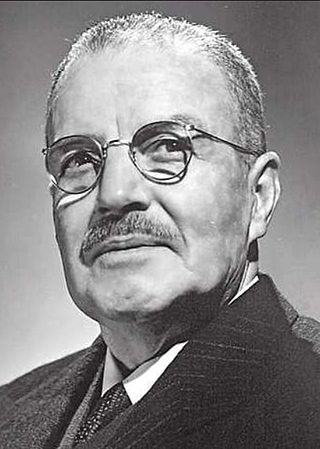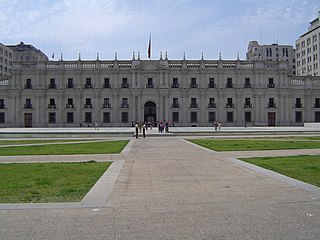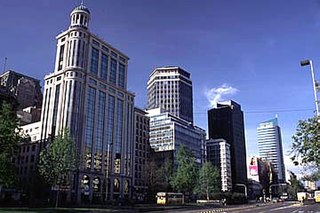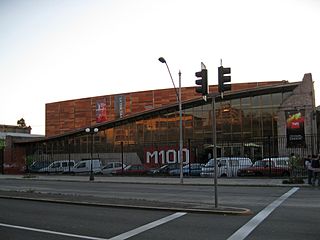
Santiago, also known as Santiago de Chile, is the capital and largest city of Chile and one of the largest cities in the Americas. It is located in the country's central valley and is the center of the Santiago Metropolitan Region, which has a population of 7 million, representing 40% of Chile's total population. Most of the city is situated between 500–650 m (1,640–2,133 ft) above sea level.

Palacio de La Moneda, or simply La Moneda, is the seat of the president of the Republic of Chile. It also houses the offices of three cabinet ministers: Interior, General Secretariat of the Presidency, and General Secretariat of the Government. Located in downtown Santiago, it occupies an entire block in the Civic District, bordered by Moneda street to the north, Morandé street to the east, Alameda del Libertador Bernardo O'Higgins to the south, and Teatinos street to the west.

Televisión Nacional de Chile (TVN) is a Chilean public service broadcaster. It was founded by order of President Eduardo Frei Montalva and it was launched nationwide on 18 September 1969. Since then, the company has been reorganized on several occasions and its operations areas have increased over the years, becoming one of the leading television broadcasters in Chile and South America. Law 17 377 of 1970 established that TVN must be a public, autonomous, pluralistic, and representative public service. TVN's public mission determines the obligation to promote the national cultural identity, the values of democracy, human rights, care for the environment and respect for diversity. Furthermore, Televisión Nacional governs the programming of its services according to criteria established by the National Television Council (CNTV).

General Carlos Ibáñez del Campo was a Chilean Army officer and political figure. He served as President twice, first between 1927 and 1931, and then from 1952 to 1958, serving for 10 years in office.

Plaza de la Ciudadanía is a public square located in the southern façade of the Palacio de La Moneda in Santiago. It used to be part of the grass garden and parking area of the Palace.

Centro Cultural Palacio de La Moneda is a cultural facility located in Santiago, Chile, under Citizenry Square, in the southern façade of the Palacio de La Moneda. It is intended to place the Chilean capital in the international cultural circuit, allowing participative and formative access for all citizens to the cultural and audiovisual richness of the nation.

The Chilean War of Independence was a military and political event that allowed the emancipation of Chile from the Spanish Monarchy, ending the colonial period and initiating the formation of an independent republic.

Avenida Libertador General Bernardo O'Higgins, popularly known as 'La Alameda', is the main avenue of Santiago, Chile. It runs east-west in the centre of the greater urban area and is 7.77 km (4.83 mi) long, and it has up to 5 lanes in each direction. It was named after Chile's founding father Bernardo O'Higgins. It was originally a branch of the Mapocho River.

The first lady of Chile is the title for the wife of the president of Chile, who is traditionally responsible for directing and coordinating activities in the social field of the presidency and also accompany the president in ceremonies or official activities, for example, on state visit. Although not an official title, it is widely used in formal protocol and has been used in some decrees.

Spanish Chileans refer more often to Chileans of post-independence Spanish immigrant descent, as they have retained a Spanish cultural identity. People of pre-independence Spanish descent are usually not considered Spanish Chileans even though they form a large majority of the Chilean population and have Spanish surnames and ancestry. This is because they rejected Spanish identity for the emergent Chilean one on the eve of national independence.

The Chilean Declaration of Independence is a document declaring the independence of Chile from the Spanish Empire. It was drafted in January 1818 and approved by Supreme Director Bernardo O'Higgins on 12 February 1818 at Talca, despite being dated in Concepción on 1 January 1818. The ceremony of independence was performed on 12 February 1818, the first anniversary of the Battle of Chacabuco.

The Kirchner Cultural Centre is a cultural centre located in Buenos Aires, Argentina. It is the largest of Latin America, and the third or fourth largest in the world.

In 2010, Mexico celebrated both the 200th anniversary of its Independence and 100th anniversary of its Revolution. The entire year was proclaimed by President Felipe Calderón as "Año de la Patria", or "Year of the Nation". 16 September 1810 is the day of the "Grito de Dolores" or Miguel Hidalgo's call to take up arms against the Spanish colonial government. The start of the Mexican Revolution is celebrated as being 20 November 1910, when Francisco "Pancho" Villa and Pascual Orozco led the first insurrectionist attack against the regime of Porfirio Díaz. Events and other promotions of these celebrations were designed to link of Mexico's identity and historic continuity. During a speech at the inauguration of the Casa de Allende Historic Museum, President Felipe Calderón called upon Mexico to use the upcoming anniversaries to reflect on where the country has been and to think about what kind of Mexico descendants will inherit in the future. He said the vision of the insurgents of the War of Independence was forward, not backward, so every celebration of these past events must consider the future as well.

The Argentina Bicentennial was a series of ceremonies, festivals, and observances celebrated on May 25, 2010, and throughout the year. They commemorated the 200th anniversary of the May Revolution, a sequence of historical events that led to the Viceroy Baltasar Hidalgo de Cisneros being ousted from office and replaced with the Primera Junta, the first national government.

The Anniversary of the First National Government is a public holiday of Argentina, commemorating the May Revolution and the creation of the Primera Junta on May 25, 1810, which is considered the first patriotic government of Argentina. Along with the 9 July, which commemorates the Declaration of Independence, it is considered a National Day of Argentina.

The Palacio de la Real Audiencia de Santiago is a building located in the north central village of the Plaza de Armas in Santiago, Chile. The building dates back to 1808 and houses, since 1982, the National History Museum of Chile.

The Official Post Service of the Argentine Republic is the state-owned company that covers the postal service in Argentina. The company is a S.A. under the country's Office of the Cabinet Chief.

The Centro Cultural Matucana 100 is a cultural center located in the commune of Estación Central in Santiago, Chile, near Quinta Normal Park. Matucana 100 is a not-for-profit corporation that hosts and plans cultural events and educational programs related to the contemporary arts including dance, theatre, music, photography, the visual arts and cinema. The center takes its name from its street address.

The Bicentennial of the Independence of Peru occurred on 28 July 2021. Its celebration commemorated 200 years since Peru's proclamation of Independence. The celebration consisted of a mix of local, state, and national activities that were planned since 2016. On 8 August 2016, the Prime Minister of Peru announced the creation of the Organizing Commission for the Commemoration of the Bicentennial of the Independence of Peru.

The Biblioteca de Santiago (BDS) is a public library in downtown Santiago, Chile. It was inaugurated on November 11, 2005 by the then president of Chile Ricardo Lagos. The library is operated by the Servicio Nacional del Patrimonio Cultural, and is the largest and most advanced public library in Chile. The library occupies an entire city block bounded by Agustinas, Matucana, Moneda and Chacabuco Streets.





















